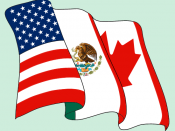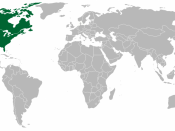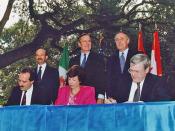Running head: REGIONAL INTEGRATION PRO'S AND CON'S
Regional Integration
Robert Nichelson
University of Phoenix
Global Business Strategies
MGT448
Shabbir Karim
Regional Integration
Support for NAFTA:
NAFTA is the North American Free Trade Agreement, it was formed to give Canada and Mexico most favored nation status. NAFTA also eliminates trade barriers and ease cross border movement of goods and services. NAFTA increases opportunities for investment and promotes fair competition. NAFTA enforces intellectual property rights and has created procedures to settle trade disputes among its members.
Supporters of NAFTA say that the accord has created democratic reform and opened new markets in Mexico improving the lives of the Mexican people and reducing poverty. The Bush administration has clamed that NAFTA has led to tax cuts averaging approximately $930 per household each year and has also led to income gains. There were over 20 million new jobs generated by NAFTA from 1993 to 2000 attributed to the free trade block.
NAFTA brought in a flood of foreign investment and contributed to a 24% rise in Mexico's per capita income. "NAFTA gave us a big push," Vicente Fox, President of Mexico, tells Business Week. "It gave us jobs. It gave us knowledge, experience, technological transfer (Pro's and Con's, 2004).
NAFTA created the world's largest free trade area, producing $15.3 trillion in goods and services annually with increases in the GDP as much as 5% each year. This is due to the elimination of tariffs spurring business growth, reducing inflation and reducing the cost of imports. Trade between the NAFTA signatories tripled, from $297 billion in 1993 to $903 billion in 2007. Specifically,
U.S. goods exports to Canada and Mexico grew 157%, from $142 billion to $364.6 billion.
Exports from Canada and Mexico to the U.S. grew 231%, from $151 billion in to $501...


